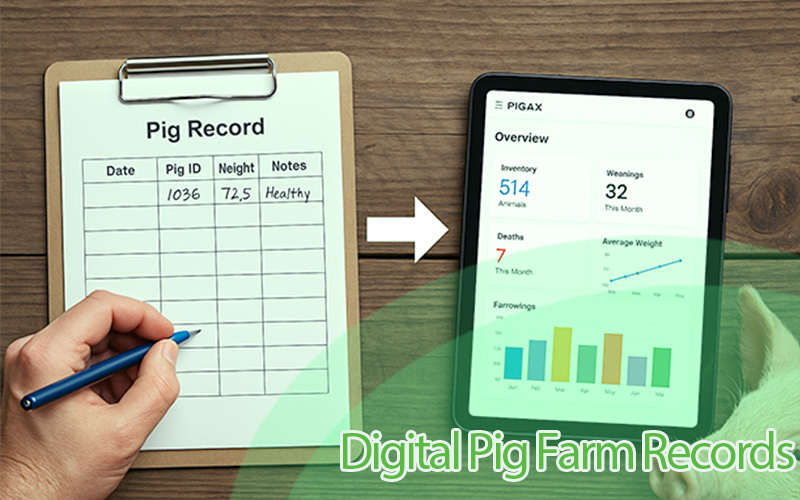Best approach to maintaining pig weight records
Tracking pig growth is a vital aspect of improving farm efficiency and productivity. By closely monitoring and managing the growth of pigs, farmers can make informed decisions to optimize their operations. One tool that has revolutionized growth monitoring and management is Pigax pig management software. This innovative technology streamlines processes improves data accuracy, and enhances farm efficiency through data-driven decisions.
This innovative technology streamlines processes improves data accuracy, and enhances farm efficiency through data-driven decisions. In this article, we will explore the benefits of pig management software for tracking pig growth and delve into various aspects of growth monitoring, including indicators, data collection, and analysis. We will also discuss the importance of real-time alerts, nutritional management, growth monitoring techniques, early detection of growth issues, integration with sensor technologies, collaboration, and performance analysis.
How to track Pigs growth
To know the rate at which your pigs are growing, you need to do some calculations which is more convenient when using a Pig management App. Let us now go through 3 metrics you must know in order to figure out the rate at which your pigs are growing.
1. Calculate the Average Daily feed Intake
2. Calculate the Avergare Daily Gain (ADG)
3. Calculate the Feed Conversion Rate(FCR)
Now lets go over them one after the other.
Average Feed Intake (AFI)
AFI stands for average daily feed intake, which is a measure of the amount of feed that a pig consumes on a daily basis. AFI is typically expressed in kilograms per day or per pig. To calculate AFI, the total amount of feed that a pig consumes is weighed over a specific period of time (such as a week or a month) and then divided by the number of days in that period. This provides the average daily feed intake for that period. This is can then be recorded down in a software to keep track.
AFI is an important indicator of the feeding behavior and nutritional status of a pig, and it is often used to assess the impact of different management practices on feed intake and to make comparisons between different herds. Factors that can affect AFI include genetics, feed and nutrition, health and disease management, housing and facilities, and environmental factors.
To improve AFI in pig farming, it is important to focus on factors that can affect feed intakes, such as providing a balanced and nutritious diet, managing health and disease effectively, and optimizing housing and facilities. It is also important to monitor AFI regularly and to make any necessary adjustments to management practices in order to maintain good feed intake and productivity.
Avergare Daily Gain (ADG)
In pig farming, ADG stands for average daily gain, which is a measure of the average amount of weight that a pig gains per day. Average daily gain is an important indicator of the growth and productivity of a pig herd, and it is often used to assess the effectiveness of different management practices and to make comparisons between different herds. A high average daily gain indicates that the pigs are growing well and that management practices are effective, while a low average daily gain may indicate that there are problems that need to be addressed.
To calculate average daily gain, the weight of a pig is measured at regular intervals (such as weekly or monthly) and the difference in weight between each measurement is divided by the number of days between measurements. This provides an average daily gain for that period of time.
Average daily gain is influenced by a variety of factors which includes:
- Genetics: Pigs with good genetics will tend to have a higher average daily gain than those with poor genetics.
- Feed and nutrition: Providing a balanced and nutritious diet is essential for maintaining good growth and health in pigs. Poor quality feed, inadequate intake, or imbalanced nutrient ratios can all lead to reduced average daily gain.
- Health and disease management: Pigs that are in good health are more likely to grow well, while those that are sick or suffering from infections or other health issues may have a lower average daily gain.
- Housing and facilities: The design and management of pig housing and facilities can have a significant impact on average daily gain. For example, overcrowding or poor ventilation can lead to reduced growth and poorer overall health.
- Environmental factors: Environmental factors such as temperature, humidity, and lighting can also affect the average daily gain. For example, pigs may grow more slowly in very hot or cold conditions.
- Age: Average daily gain tends to be highest in young pigs and decreases as they get older.
Feed Conversion Rate(FCR)
In pig farming, FCR stands for Feed Conversion Ratio, which is a measure of the efficiency with which a pig converts feed into weight gain. FCR is calculated by dividing the total amount of feed that a pig consumes by the amount of weight that it gains over a specific period of time. For example, if a pig consumes 10 kilograms of feed and gains 5 kilograms of weight over a period of two weeks, its FCR would be 2 (10 kilograms of feed divided by 5 kilograms of weight gain). A lower FCR indicates that the pig is more efficient at converting feed into weight gain, while a higher FCR indicates that the pig is less efficient.
FCR is an important indicator of the efficiency and productivity of a pig herd, and it is often used to compare the performance of different herds or to assess the impact of different management practices on feed efficiency. Factors that can affect FCR include genetics, feed and nutrition, health and disease management, housing and facilities, and environmental factors.
To improve FCR in pig farming, it is important to focus on factors that can affect feed efficiencies, such as providing a balanced and nutritious diet, managing health and disease effectively, and optimizing housing and facilities. It is also important to monitor FCR regularly and to make any necessary adjustments to management practices in order to maintain good feed efficiency and productivity.
Why you Should Use Pig Management Software for Tracking Pig Growth
Pig management software offers a wide range of benefits when it comes to tracking pig growth. Firstly, it streamlines the entire growth monitoring process, eliminating the need for manual record-keeping and reducing the chances of errors or data inconsistencies. With the software's intuitive interface, farmers can effortlessly record and access growth data at any time. This accessibility also promotes collaboration among farm personnel and veterinarians, allowing for better communication and coordination in managing pig growth. Furthermore, pig management software empowers farmers to make data-driven decisions. By analyzing growth trends and patterns, farmers can identify areas for improvement, implement targeted strategies, and ultimately enhance farm efficiency and productivity. With these benefits in mind, it's clear that pig management software is a game-changer for tracking pig growth.
Monitoring Pig Growth Indicators
To effectively track pig growth, it's crucial to monitor key indicators that provide insights into their development. Measuring weight gain and growth rates is a fundamental aspect of growth monitoring. By regularly weighing pigs and recording their progress, farmers can assess their overall growth performance. Additionally, tracking body condition score helps evaluate the pigs' health and nutritional status, as it provides valuable information about their body composition. Another important indicator to consider is the feed conversion ratio (FCR), which measures the efficiency of converting feed into weight gain. By monitoring FCR, farmers can fine-tune the pigs' diets and optimize their nutritional management for better growth outcomes. Assessing growth uniformity and identifying outliers is also essential, as it allows farmers to address any variations and ensure consistent growth across the herd.
Automated Data Collection and Analysis
One of the standout features of pig management software is its ability to automate data collection. This eliminates the need for manual input, reducing the risk of human error and saving valuable time. With the software's seamless integration with various data collection tools, such as electronic weight scales and imaging systems, farmers can effortlessly capture accurate growth measurements. Furthermore, pig management software enables comprehensive data analysis. By analyzing growth trends and patterns, farmers can gain valuable insights into the pigs' development. They can identify growth plateaus, detect deviations from normal growth patterns, and take prompt action to address any potential issues. The ability to make data-driven decisions based on accurate and timely information is a game-changer for optimizing pig growth management.
Real-Time Alerts and Notifications
In the fast-paced world of pig farming, staying on top of critical growth events is essential. Pig management software offers real-time alerts and notifications, ensuring that farmers are promptly informed about any abnormal growth patterns or health conditions. By setting up customized alerts, farmers can receive notifications when specific growth thresholds are met or when there are deviations from expected growth rates. This early warning system enables farmers to take immediate action, intervening and adjusting management practices to optimize growth outcomes. Real-time alerts also help prevent potential health issues from escalating, as early detection and intervention significantly contribute to the overall well-being of the pigs. With real-time alerts and notifications, farmers can proactively manage pig growth and maximize their farm's efficiency.
Nutritional Management for Optimal Growth
Nutrition plays a crucial role in pig growth, and effective nutritional management is key to achieving optimal growth outcomes. Pig management software assists farmers in balancing pig diets for optimal nutrition. By leveraging the software's features, farmers can precisely monitor feed consumption and adjust rations based on the pigs' growth needs. This level of control allows for fine-tuning of diets, ensuring that pigs receive the necessary nutrients for healthy growth. Additionally, the software enables farmers to evaluate the impact of different feed formulations on growth performance. By analyzing the data, they can identify the most effective feed combinations, leading to improved growth rates and overall farm efficiency. With pig management software, nutritional management becomes more precise and effective, supporting optimal pig growth.
Growth Monitoring Techniques and Tools
Accurate growth monitoring relies on utilizing advanced techniques and tools. Pig management software integrates with various technologies that enable accurate growth measurements. Electronic weight scales provide precise weight data, allowing farmers to closely monitor each pig's growth progress. Imaging systems, such as ultrasound or 3D scanning, offer additional insights into the pigs' body composition and development. Implementing body condition scoring methods is another valuable technique for growth assessment. By visually assessing the pigs' body condition, farmers can gauge their overall health and nutritional status. These techniques and tools, in combination with pig management software, provide a comprehensive approach to tracking and analyzing pig growth.
Early Detection of Growth Issues and Health Problems
Early detection of growth issues and health problems is crucial to maintaining optimal pig growth. By closely monitoring growth patterns and assessing the pigs' overall development, farmers can identify deviations from expected growth trajectories. This early detection allows for prompt intervention and treatment, preventing further growth problems or health complications. Regular growth monitoring also helps identify growth plateaus, where pigs may temporarily halt their growth progress. By recognizing these plateaus, farmers can adjust management practices and provide the necessary interventions to overcome them. The ability to proactively address growth issues and health problems ensures that pigs receive the best care and support for their continuous growth and well-being.
Integration with Sensor Technologies
Pig management software can be seamlessly integrated with sensor technologies, providing farmers with a comprehensive approach to growth monitoring. Environmental factors, such as temperature, humidity, and ventilation, significantly impact pig growth. By integrating sensor technologies with the software, farmers can monitor these factors in real-time. This integration enables them to adjust environmental conditions to create an optimal growth environment for the pigs. By maintaining ideal conditions, farmers can promote better growth outcomes and ensure the overall well-being of the animals. The integration of sensor technologies with pig management software empowers farmers to take a holistic approach to growth monitoring and management.
Collaboration and Communication
Effective collaboration and communication among farm personnel and veterinarians are essential for successful growth monitoring. Pig management software facilitates seamless collaboration by providing a platform for sharing real-time growth data and observations. Farm personnel and veterinarians can access the same data, enabling them to work together towards optimizing pig growth outcomes. By sharing insights and discussing growth trends, they can collectively make informed decisions and implement strategies for continuous improvement. This collaborative approach enhances the effectiveness of growth monitoring and contributes to overall farm efficiency and productivity.
Performance Analysis and Benchmarking
Analyzing growth data is crucial for evaluating farm performance and benchmarking against industry standards and best practices. Pig management software allows farmers to analyze growth data in a comprehensive and systematic manner. By reviewing growth trends, growth rates, and other relevant metrics, farmers can gain insights into their farm's performance. Benchmarking against industry standards and best practices helps identify areas for improvement and sets a benchmark for success. By leveraging the data-driven approach of pig management software, farmers can implement targeted strategies to enhance growth outcomes, streamline operations, and maximize farm efficiency.
Conclusion
In conclusion, tracking pig growth using pig management software is a game-changer for improving farm efficiency and productivity. By streamlining growth monitoring processes, enhancing data accuracy and accessibility, and enabling data-driven decisions, pig management software empowers farmers to optimize pig growth management. From monitoring growth indicators and automating data collection to leveraging real-time alerts and integrating sensor technologies, this software offers a comprehensive solution for effective growth monitoring. By fostering collaboration, enabling nutritional management, and facilitating performance analysis, pig management software contributes to enhanced farm performance. Embracing pig management software is a wise choice for pig farmers looking to enhance growth outcomes, improve farm efficiency, and achieve success in their operations.




